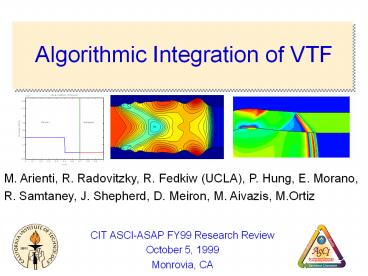Algorithmic Integration of VTF - PowerPoint PPT Presentation
1 / 17
Title:
Algorithmic Integration of VTF
Description:
Algorithmic Integration of VTF. CIT ASCI-ASAP FY99 Research ... Explicit time marching. TVD Runge-Kutta. EoS. perfect gas, Mie-Gr neisen, JWL. Chemical reaction ... – PowerPoint PPT presentation
Number of Views:75
Avg rating:3.0/5.0
Title: Algorithmic Integration of VTF
1
Algorithmic Integration of VTF
M. Arienti, R. Radovitzky, R. Fedkiw (UCLA), P.
Hung, E. Morano, R. Samtaney, J. Shepherd, D.
Meiron, M. Aivazis, M.Ortiz
- CIT ASCI-ASAP FY99 Research Review
- October 5, 1999
- Monrovia, CA
2
The Challenge
- Develop Virtual Test Facility
- First step 2D serial prototype
- explore technical issues
- proof-of-concept for 3D parallel facility
Metal confinement
Compressible Fluid Dynamics in dense gas
High Explosive
Nonlinear Solid Dynamics with high strain
rates, plastic deformation and fracture
Detonation Wave with resolved reaction zone
Shock Waves
3
The Process
- How we went about it
- Identified a concept
- ghost fluid method (Aslam and Fedkiw)
- Explored issues in 1D and 2D (w/Fedkiw)
- Developed modular 2D prototype
- started development with Fedkiw
- simplified solid models and shock waves
- Defined interfaces with Adlib
- core team of Arienti, Radovitzky, Morano, Hung,
Aivazis - Modified Adlib and implemented interfaces
- Prototype integrated with Adlib, HE models for
detonation - Samtaney implementation - a variation on these
ideas in his parallel 3D fluid mechanics
simulation software
4
Modular Architecture
Time_Step
Eulerian
Make_Grid
Lagrangian
Make_Grid
Coupling
Fluid_Solver
Solid_Solver
EoS
Init_Fluid
Init_Solid
Materials
5
Equation Framework Fluid model
Eulerian formulation
- Finite difference or volume ENO, Roe-Glaister,
Godunov - Explicit time marching TVD Runge-Kutta
- EoS perfect gas, Mie-Grüneisen, JWL
- Chemical reaction single and multi-step
6
Equation Framework Solid model
- Lagrangian formulation
- Lumped Mass Structural models
- Euler-Bernoulli Beam
- Finite-Element Lagrange (Adlib)
7
Framework for Fluid-Solid Coupling
- Two solver modules, fluid and solid
- Advance solutions, exchange information at
boundary - boundary location (X, Y, Z)
- boundary conditions (P,u,stress, acceleration,)
- Represent physical boundary as level set
- Solid computation provides master boundary
coordinates - Level set reconstructed at each time level
- slip boundaries, non-reactive, inviscid
- ghostfluid method GFM (Aslam and Fedkiw)
extrapolation - Modified GFM with acceleration corrections (IRP)
- standard impermeable rigid-boundary condition
8
Boundary Conditions
- Continuity of normal velocity Un
- Tangential slip Ut
- Continuity of normal component of traction force
F
SOLID
Boundary
F
FLUID
9
Ghost Cells
- Required at boundary for all finite-difference/vol
ume schemes - What values should be put in ghost cells?
- Exact Solution to Inverse Riemann problem at
interface - Approximate
- ghostfluid method
- reflection boundary conditions (a la rigid
walls) - modified GFM with acceleration corrections
- subject of ongoing investigation
10
Level Set Representation of Interface
- Level set is signed distance function f (Osher
et al) - solid fgt0
- fluid flt0
- interface f0
- Normal defined as gradient of f
- Used to extrapolate boundary values into ghost
fluid region using Advection Equation - Capture interface, no cut cells, location
determined by solid - novel technique
11
1D test - Lagrangian Solid
- Shock impacting solid material
- Eulerian Perfect gas EoS, ENO LLF.
- Lagrangian solid (no strength) with artificial
viscosity - Coupling GFM
12
2D Tests
- Shock propagating between beam elements
- Shock propagating between spring/mass elements
13
2D Test with Adlib
- Shock impacting test material
- Materials neohookean steel, copper (test)
and perfect gas- Geometry axisymmetric -
Initial conditions Mach number 3 - Models
Eulerian ENO LLF, Adlib - Coupling reflecting BC
14
2D test - HE model with Adlib
- Detonation in a tube
- Materials neohookean steel around HMX
cylinder (MG JWL EoS) - Geometry test material
at the bottom of an axis symmetric case - Initial
conditions Chapman-Jouguet point, the detonation
zone starts at x0 - Models Euler, JTF, Adlib -
Coupling reflecting BC (internal energy instead
of pressure)
15
Detonation in a Tube (Cylinder Test)
Compression Wave
Steel tube
vacuum
Detonation Wave
Fluid-solid boundary
Products
Reactants
Reaction zone
16
Prototype VTF Accomplished!
- Started from scratch in Oct 1998
- Inter-group, inter-disciplinary team effort
- Extensive 1D, 2D shock wave learning experience
- Simplified models of solids with progression to
full Lagrangian FEM modeling. - Shock waves in ideal gases progressing to
detonations in high explosives - Transition of methodology from serial to parallel
implementation - Successful accomplishment of all FY99 goals for
VTF - Building blocks in place for FY00 program
17
Looking back on FY99
18
VTF Simulation of Overarching Application































